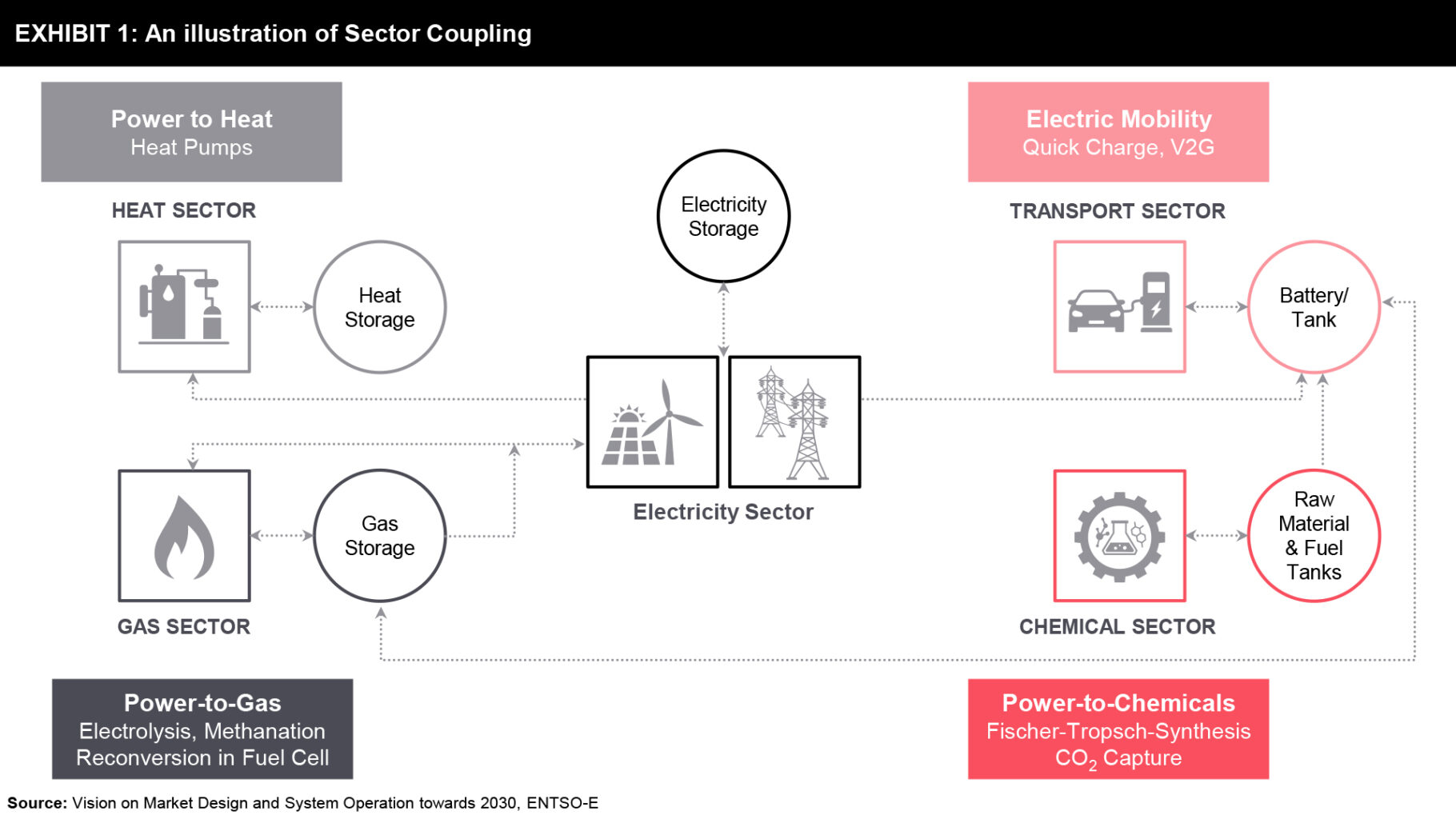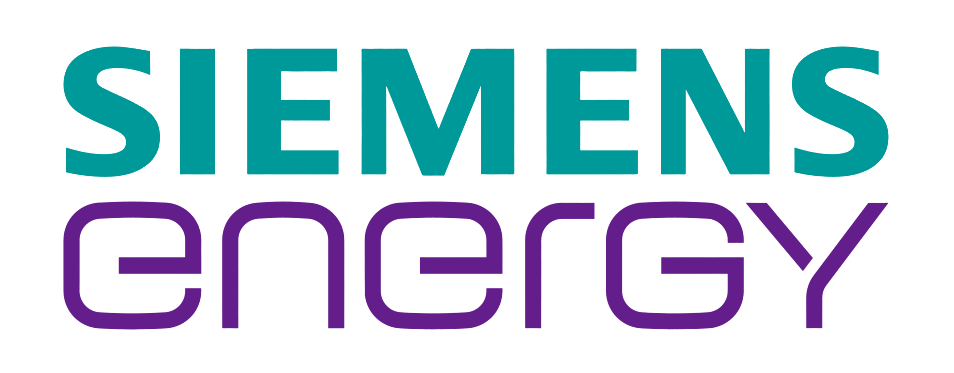With the increasing impacts of climate change and new legislation addressing these complex issues, the energy sector is undergoing phenomenal changes. The EU has increased its GHG emission reduction targets to at least 55% by 2030 and 80-95% by 2050, below 1990 levels. The EU Green Deal and the Clean Energy Package (CEP) have further added legislative support to the EU’s climate targets. The EU green deal plans investments of nearly more than €1 trillion in clean, affordable energy & mobility while aiming to decarbonize transport, heating, and industry. With regards to energy particularly, the CEP, a set of 8 legislative acts, focuses on energy governance, energy efficiency improvements, renewables, and market design. Therefore, with multiple end-use sectors being affected, Sector coupling is gaining attention due to the scale of decarbonization it offers.
In simple terms, sector coupling is the integrated approach by all sectors (electricity, gas, heat, transport, and industry) to use energy in a sector being generated in another sector, with an overall increase in efficiency. There is a strong political drive in Europe towards coupling sectors, where technologies like the power to X – X being gas, heat, transport, or products – are coming into play. Either dependent in terms of black start capabilities or flexible in the form of exchange, electricity and gas are both complementary.
Therefore, sector coupling can contribute to the cost-efficient decarbonization of the energy system, by valuing potentials interlinkages between different parts of the energy system. However, several limitations in place currently do not easily facilitate a complete end-use sector coupling and cross vector integration. What are the barriers in place?
Barriers: Techno-Economics, Market & Regulatory Framework
Despite the benefits of sector coupling, there are several barriers to mature and experimental sector coupling. An important techno-economic barrier is that several of the technologies, currently in use as well as those in development, are not yet competitive in many applications and regions. Their performance needs to be improved further while the necessary design and operation standards and energy efficiency labels have to be developed.
Market conditions are also restrictive because fossil fuels are available at comparatively low prices, or due to competing, more profitable applications of certain resources (e.g. biomass). While stability in regulatory and market conditions is highly desirable, its absence leads to uncertainty on the business case and deters investments. Further, resource limitations definitively shape the viability of sector coupling technologies in certain regions. Many technologies rely on the availability of suitable infrastructure, which can require the expansion or refurbishment of existing infrastructure or investment in new dedicated infrastructure. This can be substantial and require the development of new standards (e.g. for injecting hydrogen in gas grids).
Policy and regulatory barriers to sector coupling begin with gaps in the integrated planning and operation of energy carriers and levels. The current design of the energy market is also a barrier to sector coupling technologies, either by hindering the participation of sector coupling technologies in specific markets or by not internalizing all positive and negative externalities of low- and carbon-intensive technologies.
The flexibility services provided by sector coupling technologies are not sufficiently rewarded by certain gas and electricity network tariffs. Power-to-gas facilities may be treated as end consumers and face electricity input costs that include end-user taxes and levies. Furthermore, with the anticipated decline in gas transported, average infrastructure tariffs could be expected to increase to ensure recovery of sunk investment costs.
Some of the following recommendations carry potential in addressing these systemic and specific barriers.
Potential Recommendations
To ensure that new investments are future-proof and minimize overall system costs, firstly, integrated holistic planning and operation of energy infrastructure are needed, considering interlinkages between the electricity, gas, and heat sectors. Second, energy policies should be consistent and provide adequate incentives for flexible, low-carbon technologies and consider the interactions of both high level and targeted energy and climate legislation. Interventions via climate and renewable policy and support for innovation should be designed to address barriers and gaps related to the relative immaturity of sector coupling and low-carbon and renewable gas technologies.
Third, the future role of hydrogen should be further assessed, and measures are needed to facilitate its deployment. With its increasing relevance in the energy mix, and therefore to sector coupling, energy policymakers and regulators must seek to facilitate the increased crossover between the power and natural gas systems, and work to reduce technical and regulatory barriers to the injection of hydrogen into the gas grid. This cross vector integration will enable the flexibility needed for large-scale grid power systems.
Fourth, if energy (service) markets are made to reflect positive and negative externalities, a level playing field is provided, for all technologies and carriers contributing to energy supply. Therefore, aspects such as cost-reflective energy price signals, adequate carbon pricing, market accessibility and liquidity, and appropriate network tariff structures should be considered. Finally, EU policy stimulating research, development, and innovation should specifically focus on integrated energy system planning and operation, and facilitate high-risk innovations.
Key Developments
Several scenario-based case studies were performed by TSOs and gas infrastructure companies in addition to simulation studies by private consulting agencies and academia. Tennet and Gasunie are the electricity & gas transmission system operators respectively, operating in the Netherlands & Germany. They have performed scenario-based studies to show the requirement of multiple energy vectors in the energy mix and are developing a necessary strategy to achieve the same. An example of the sector coupling strategy for Denmark is shown. Exhibit 2 briefly discusses the strategy of Denmark, from Energienet, owned by the Danish Ministry of Climate, Energy & Utilities, which operates and develops transmission systems for electricity & gas in Denmark.
Going Forward
Heat and hydrogen production from renewables can boost system flexibility and help with energy decarbonization. Electric boilers, electric vehicles (EVs), heat pumps, and electrolyzers for hydrogen production provide additional flexibility to the power system. By adjusting their demand profile based on price signals and making a source of energy storage for the power system, it decouples the timing of demand for final energy from electricity demand.
The European energy system will need to facilitate the adoption of not only increased Renewables and storage but also help redesign a circular energy system that efficiently integrates hard-to-decarbonize sectors (shipping, aviation, steel, manufacturing, etc.). This can be achieved by sector coupling, which is an important means to achieve the EU climate objectives and the EU Green Deal’s vision for a carbon-neutral EU economy by 2050.
References
- Potentials of sector coupling for decarbonization – Assessing regulatory barriers in linking the gas and electricity sectors in the EU.
EU Commission, Frontier Economics, and CE Delft; 2019. - Sector coupling: how can it be enhanced in the EU to foster grid stability and decarbonize?
EU Commission, Trinomics B. V.; 2019 - Sector Coupling: Concepts, State-of-the-art and Perspectives.
European Technology & Innovation Platform, Smart Networks for Energy Transition (ETIP SNET); 2020. - Vision on Market Design and System Operation towards 2030.
European Network of Transmission System Operators – Electricity (ENTSO-E); 2020.




 6 min read
6 min read
































